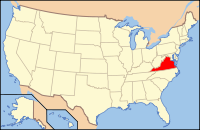Isle Of Wight County, Virginia
| Isle of Wight County, Virginia | ||
|---|---|---|

The 1800 courthouse near the center of Isle of Wight County
|
||
|
||
 Location in the U.S. state of Virginia |
||
 Virginia's location in the U.S. |
||
| Founded | 1634 | |
| Named for | Isle of Wight | |
| Seat | Isle of Wight | |
| Largest town | Smithfield | |
| Area | ||
| • Total | 363 sq mi (940 km2) | |
| • Land | 316 sq mi (818 km2) | |
| • Water | 47 sq mi (122 km2), 13.0% | |
| Population (est.) | ||
| • (2015) | 36,314 | |
| • Density | 100/sq mi (39/km²) | |
| Congressional district | 4th | |
| Time zone | Eastern: UTC-5/-4 | |
| Website | www |
|
Isle of Wight County is a county located in the U.S. state of Virginia. It was named after the Isle of Wight, in the English Channel. As of the 2010 census, the population was 35,270. Its county seat is Isle of Wight.
Isle of Wight County is located in the Virginia Beach-Norfolk-Newport News, VA-NC Metropolitan Statistical Area.
Isle of Wight County features two incorporated towns, Smithfield and Windsor. The original courthouse for the county was built in Smithfield in 1750. The original courthouse and its associated tavern (The Smithfield Inn) are still standing. A new courthouse was built near the center of the county in 1800. The 1800 courthouse and its associated tavern (Boykin's Tavern) are also still standing. The 1800 courthouse is used daily, and is the government chambers for the Board of Supervisors, as well as the meeting hall for the School Board. The chambers still occasionally serve as an actual courthouse for civil trials if the new courthouse is fully in use. The new courthouse opened in 2010 and is just across the street from the sheriff's office and county offices complex.
During the 17th century, shortly after establishment of the settlement at Jamestown in 1607, English settlers explored and began settling the areas adjacent to Hampton Roads. Captain John Smith in 1608 crossed the James River and obtained fourteen bushels of corn from the Native American inhabitants, the Warrosquyoackes or Warraskoyaks. They were a tribe of the Powhatan Confederacy, who had three towns in the area of modern Smithfield. The Warraskoyaks were driven off from their villages in 1622 and 1627, as part of the reprisals for the Great Massacre of 1622.
...
Wikipedia

